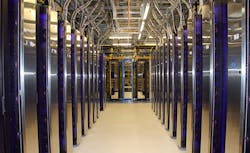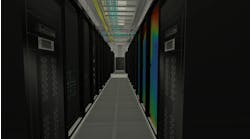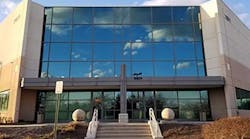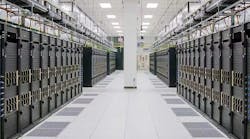At Data Center Frontier our eyes are on the horizon. We’re always talking with industry thought leaders about what’s next for the industry. Our crystal ball did pretty well in 2018, so it’s time to look at what’s in store for 2019.
We’ve identified eight themes that will shape the data center business this year. We’ll be writing in more depth about many of these trends in coming weeks, but this list provides a high-level view of the topics that we believe will be relevant this year.
1. Hyperscale Deals Get Bigger
Industry watchers keep waiting for the demand for hyperscale data centers to ease. I mean, the campuses and leasing deals can’t possibly keep getting bigger, can they?
They can, and they will in 2019. The continued super-sizing of leases was highlighted by CloudHQ founder Hossein Fateh (Hyperscale Data Center Deals Will Get Bigger. Much Bigger), who predicted that by 2022 the industry will see deals for 350-megawatt campuses. Fateh has been a leading builder of hyperscale facilities, and in 2018 CloudHQ reportedly signed a 72-megawatt lease in Ashburn, the largest deal in data center history.
That record likely won’t last long. Multiple industry sources say that there will be a 100-megawatt deal in 2019, and maybe more than one.
Compass Datacenters CEO Chris Crosby says that in the next two years the hyperscale sector will deploy massive amounts of capacity, roughly equivalent to the space they deployed over the previous five years combined.
“There’s a lot of campuses yet to be announced for the big cloud guys, and there’s a lot of capacity needed for the next tier of SaaS providers,” said Crosby.
“I don’t think everybody fully appreciates the extent to which the hyperscale companies will provide a tailwind to the industry over the coming years,” said Gary Wojtaszek, the CEO of CyrusOne, a major provider of hyperscale space. “Our sales funnel is up significantly and is again at a record level, primarily driven by hyperscale demand that is well above the level we had previously been tracking. We expect this demand to continue for years to come and, in fact, accelerate globally.”
“The large (cloud providers) are all talking about needing a gigawatt of capacity over the next five years,” added Diane Morefield, the Chief Financial Officer of CyrusOne. “These are enormous amounts of capital required to support that growth. So the conversations that we’re having are really big. The deals are really large. And we don’t see that trending down.”
2. Niches Abound: A Market of Markets
The big hyperscale deals make headlines. In fact, as we noted this fall, hyperscale computing has emerged as a new market segment within the data center industry, with requirements for scale, speed-to-market and pricing that a limited number of providers can meet. Winning hyperscale deals requires new approaches to construction and leasing,
But hyperscale is just one niche within an increasingly diverse set of opportunities for data center developers and service providers. Market segmentation is emerging within the traditional categories of wholesale (dedicated data halls, suites and build-to-suits) and retail colocation (multi-tenant environments with tenants renting cabinets and cages).
As some wholesale players target the 50-megawatt hyperscale deals, it creates an opportunity for others to focus their operations and sales efforts on 2 to 5 megawatt requirements. Expect to see an emerging opportunity in the 5 to 15 megawatt range, catering to large SaaS providers and second-tier cloud players. On the colocation front, there are targeted opportunities in major markets, second-tier markets, and interconnection strategies – including new connectivity ecosystems at landing sites for subsea network cables.
But the biggest and broadest set of opportunities may be in the nascent field of edge computing.
“In our view, edge computing is a large category that will include hundreds of markets and ecosystems,” said Thomas Bittman, a Distinguished Analyst with Gartner Research. “We believe there are many edges. It’s a rich, complex, diverse set or markets.
“There will be a lot of different players, and a lot of vendors,” Bittman added. “The cloud guys will play, and there will be point providers.We’ll see vendors try to be horizontal, and others focus on very thin verticals.”
Opportunity abounds, across cloud, colo and edge. For service providers, where you can play may be guided by your cost of capital, supply chain and ability to acquire talent.
3. Staffing Challenges Test the Industry
As we noted in our recent executive roundtable, finding quality staff is becoming a challenge, and will grow in urgency in coming years with the graying of the existing workforce.
“It’s getting hard to recruit for many roles,” said Kris Von Riper, Managing Vice President at Gartner. “The ability to hire and time to fill are being tested. Put as much urgency into your talent strategy as you previously have on your technology strategy.”
One of the most important challenges is in data center construction, where teams are being tasked with building bigger and faster, across multiple major markets.
“The availability of quality contractors is an issue,” said Chris McLean, Director of Mission Critical Solutions at MC Dean. “There’s a lot of conversations now in markets where labor is constrained. You can bring contractors in from other areas. The modular construction strategy also takes workers off site. There’s a big benefit in not taxing the local labor market, and moving that work to a factory.”
Construction on Building L, the massive Digital Realty data center on its newest campus in Ashburn, Virginia. (Photo: Rich Miller)
The industry’s largest players are mindful of this challenge, as noted by Digital Realty Chief Technology Officer Chris Sharp during a recent earnings call.
“Because of the competitive dynamic that exists in the market today, I would tell you that the talent that is required to build out these facilities is becoming extremely scarce,” said Sharp. “And that’s why we continue to secure long-term contracts with the appropriate people to do the very complex installs and builds.”
Network infrastructure is another area where the rapid pace of growth is testing company’s ability to keep pace – and sometimes the endurance of key specialists.
“There is a real risk that the level of activity causes burnout on your network team,’ said Ross Winser, Research Director in Gartner’s Infrastructure and Operations Leadership group. “We need to invest in automation to get time back.”
Indeed, while industry groups mobilize to train and recruit new talent, there’s a parallel effort to harness automation, robotics, artificial intelligence and augmented reality to address looming staff limitations. That includes everything from EdgeConneX using sensors and software to operate data centers in “lights out” mode to DE-CIX creating a robot (dubbed Patchy McPatchbot) to manage network connections at its Frankfurt interconnection hub.
“The Baby Boomers will be retiring, and we’ve got to digitize that knowledge,” said Rob Johnson, the CEO of Vertiv, which is working to capture the expertise of experienced staff and create visual guides to procedures and deliver them via AR goggles or heads-up display systems.
“With AI and augmented reality we can have people working on a site and learning in 3D with step by step, just-in-time training,” said Johnson. “It’s a matter of digitizing that knowledge and creating a walk-through training experience. We’re in the early days of doing that.”
4. New Money: Deeper Pockets, Longer Horizons
There’s a whole new class of investors in the data center sector, including infrastructure funds and sovereign wealth funds with deep pockets and extended time horizons. Their activity has been scaling up over several years, but 2019 is the year where their impact will be felt, in the form of data center campuses in major markets.
This includes investors like Stonepeak Infrastructure (Cologix), Macquarie Infrastructure Partners (Aligned Energy) and GIC, the sovereign wealth fund for the government of Singapore, which is backing EdgeCore. You can see the trend in Ashburn, where Cologix, Aligned and EdgeCore are all developed campuses of between 100 MW and 180 MW of capacity, supported by the financial strength of their investors.
Infrastructure funds, which traditionally have invested in projects like airports and toll roads, tend to have longer timelines for return on investment than private equity funds, which have been the prime movers in data center investing.
The impact of infrastructure funds could be huge, according to CyrusOne CEO Wojtaszek, who sees the data center sector being valued differently by private and public investors.
“There is roughly $70 billion of private equity capital being raised currently to go into infrastructure funds, which are predominantly digital infrastructure funds – so data centers, fiber, and towers,” said Wojtaszek. “You have some of the smartest money in the world raising $70 billion of funds and going after the similar types of investments that we are. There’s a huge disconnect between the opportunity that some of these big funds are seeing over the next several years, versus how the public equity markets are seeing it.”
5. Construction Gets Leaner, Meaner
Profit margins and return on invested capital will be an important topic this year, particularly for publicly-held data center companies that are scrutinized every quarter by Wall Street analysts. This has been a strength for data center REITs (real estate investment trusts), which historically have generated better return on capital than REITS focused on other asset classes, like shopping malls or office properties. Recently these analysts have grown wary about margin compression.
With more new players entering the data center sector, pricing could become even more competitive. For some developers, this will mean finding ways to generate the same return with slightly lower leasing rates. This shifts the focus to the cost of capital and the cost per megawatt to deploy new capacity.
This is one half of the 60,000 square foot data hall inside the CyrusOne Sterling V data center in Northern Virginia. (Photo: Rich Miller)
Investment grade credit ratings may seem like a boring topic. But investment grade ratings will get sexier in 2019, as they translate into the ability to borrow money at lower interest rates. This has been a competitive advantage for Digital Realty, which is currently the only company in the sector with an investment grade rating. CyrusOne and Equinix are both working hard to join the club in 2019.
You can also expect to see more use of securitization, a strategy used by Vantage Data Centers to lower its borrowing costs for a $1.1 billion credit line. Relationships will also matter, as data center builders leverage the strong credit of parent companies, investors or partners (i.e. RagingWire Data Centers being able to build at parent NTT’s cost of capital).
The same phenomenon may be seen in construction, where the relentless focus on cost and speed will continue. Developers may look to partners for advantages in the data center supply chain, as CyrusOne has indicated it is pursuing through its work with Chinese hyperscale specialist GDS. Any provider pursuing hyperscale deals will also be pursuing a more efficient supply chain and construction operations.
6. Enterprise: All Aboard the Hybrid Train
The enterprise shift to colo and cloud was our top trend last year. It will be a big business driver once again in 2019. It’s not new or sexy, but it is a major driver of data center growth, along with new technology adoption. There are subtle shifts along the curve in the way this shift is described and spun, as seen in the embrace of “hybrid” in 2018. The bottom line is that we’ll continue to see a rational reallocation of enterprise IT resources across cloud platforms, colocation facilities and on-premises data centers.
“We’re hearing a consistent message from enterprises: They want to be out of the data center business,” said David Cappuccio, Distinguished Analyst at Gartner. “It’s not their core business.”
“Infrastructure is not dead, but there’s less and less reason to have a corporate data center,” said Steve Madden, Senior Director of Global Solution Marketing at Equinix. “Architecture is key.”
This transition has been a gradual process, and will continue for years. But Madden sees signs that leading enterprises will face pressure to move more quickly in 2019, as industries are disrupted by the success of early movers in the digital business transition.
“The data center is now a revenue stream,” said Madden. “Ecosystem-based businesses will scale faster than traditional businesses. Competitive advantage will begin to make itself felt. Those who’ve done the work will begin to excel.”
7. Liquid Cooling: Finally Ready For Its Closeup?
Yeah, I know. The imminent arrival of large-scale liquid cooling is one of the longest-running predictions, and always seems to hover near the horizon. But the rise of high-density workloads for AI is nudging this trend ahead in a meaningful way. In 2018 there were two news events that suggested we’re finally on the brink of more meaningful adoption of liquid cooling.
A row of racks filled with Google’s AI hardware, known as TPUs. (Photo: Google)
The first was Google’s adoption of liquid cooling for its latest AI hardware, as the heat generated by its new Tensor Processing Units (TPUs) exceeded the limits of its previous data center cooling solutions. Google and other tech giants are all-in on AI as a tool to infuse all their products and services with intelligence and personalization. Facebook, Microsoft and Amazon are on similar trajectories, and all will seek ever-more powerful hardware to realize this ambition. Liquid-cooled data halls for AI applications will become a common feature in future requirements.
The other eye-catching news headline was the 15-megawatt deal signed by Skybox Data Centers to deploy a massive immersion cooling project for DownUnder GeoSolutions (DUG) in Houston. These type of HPC and supercomputing installations are typically focused on custom facilities in government labs or universities. The Skybox deal suggests that wholesale data center operators may find opportunities in high-density liquid cooling, particularly for requirements with a time component.
Digital Realty agrees. “High-density chip designs and ever-increasing rack densities will require ongoing innovation in cooling technologies that only the data center industry can provide,” the company said in its outlook for 2019. “Rather than try to keep up with the rapid pace of innovation (and the capital investment that often goes along with it), enterprises increasingly will choose to rely on data center providers with deep experience and expertise in advanced cooling design capabilities to meet higher demand, including what is needed to stay ahead of the technology curve and minimize associated costs.”
8. Edge Transition: A ‘Boring’ Present Sets Up the Sexy Future
In many ways, 2018 was the year of Edge Enthusiasm, chock full of ambitious visions for a world transformed by new technologies. And yes, more than a little hype and “edgewashing.” We see 2019 as a transition year, as the market awaits the full arrival of 5G wireless which many analysts see as a 2020 event. Many of the hot new latency-focused will take time to generate demand.
But there will be plenty of action on the edge in 2019. Most of the here-and-now applications for edge infrastructure involve the growing tsunami of data that must traverse the network. Gartner analyst Bob Gill sees demand for “data thinning” to create smaller sets of actionable data as bits make their way from the edge to the cloud.
Managing bandwidth economics is a focus for Compass EdgePoint, which has been busy but low-key since its launch last year. “We’ve honed in on a boring old story of bandwidth economics,” said Sharif Fotouh, the founder and CEO of Compass EdgePoint. “That’s very different from the discussion we see in the market today.”
“There’s a myriad of applications for edge computing. If you’re not focused on what’s super-sexy, there’s still plenty of business,” said Chris Crosby, CEO of Compass Datacenters, which acquired EdgePoint last year. “The key is finding hard, credible business drivers. The real killer application right now is avoiding backhaul costs.”
Crosby says a meaningful number of companies are electing to leapfrog their network transition, skipping the move to 100Gb networks to proceed directly to 400G in their networks (Note: A prediction first made by networking pioneer Andy Bechtolsheim in a Data Center Frontier article from 2016). That means more data sooner, atop the strong existing growth.
“The amount of traffic traversing the network is astronomical,” said Phillip Marangella, Chief Marketing Officer at EdgeConneX. “There’s no end in sight. The volume and velocity of these traffic flows are mandating a rearchitecting of the Internet.
“I see a lot of buzz in the market around edge,” Marangella added. “What people seem to have forgotten is that we’ve been doing it for seven or eight years now. What we’re doing is real, and we’ve got real revenue and real customers.”






